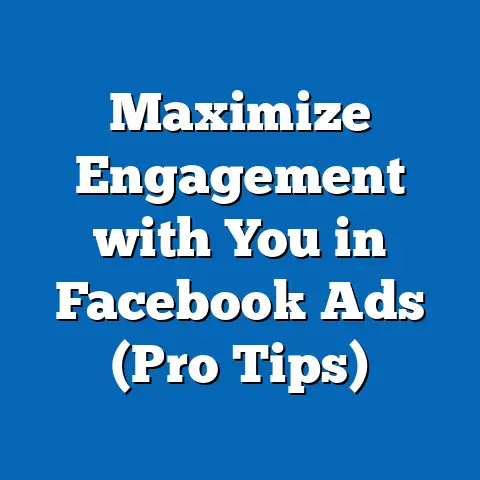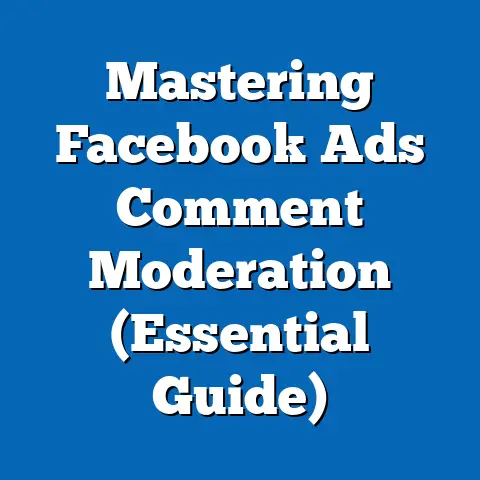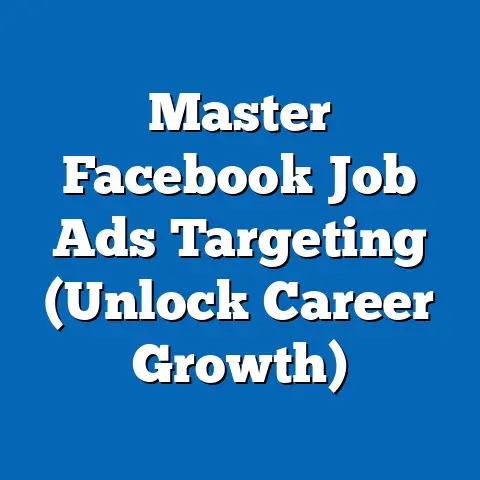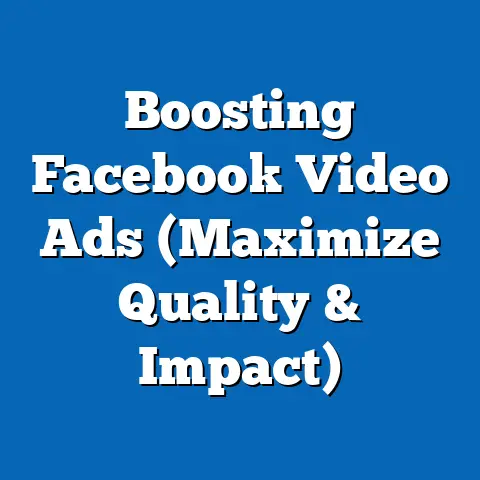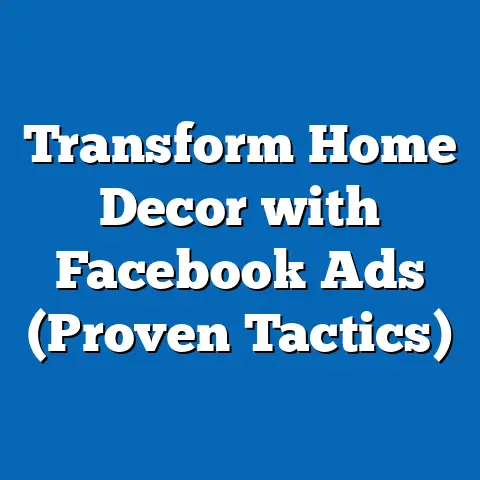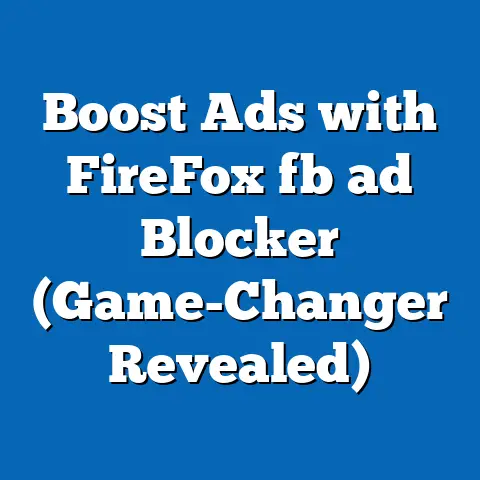Boost Columbus GA Facebook Ads Strategy (Pro Tips)
Imagine walking into a room that’s cluttered and disorganized. It feels overwhelming, right? Now, picture a space that’s clean, organized, and inviting. The difference is night and day! That’s how I see a well-structured Facebook Ads strategy – it creates an inviting space for potential customers, just like a clean home does. But just like cleaning your house, you can’t just start throwing things around; you need a plan. That’s why, before we dive into the specifics of boosting your Facebook Ads in Columbus, GA, it’s crucial to start with a clean slate: understanding the fundamentals and tailoring them to our local market. Let’s get started!
Understanding the Columbus Market
Columbus, Georgia, isn’t just another city on the map; it’s a vibrant community with its own unique rhythm. To really nail your Facebook Ads strategy here, you need to understand the local landscape. We’re talking demographics, the economic vibe, and the little quirks that make Columbus, GA, special.
Think about it: Columbus has a diverse population, with a significant military presence due to Fort Benning. This impacts everything from the types of products and services that are in demand to the language and imagery that resonates with people. The economic landscape is also evolving, with a mix of traditional industries and growing tech sectors.
I’ve learned that one-size-fits-all marketing just doesn’t cut it here. You need to tailor your ads to speak directly to the Columbus audience. This means considering factors like local interests (think Chattahoochee River activities, RiverCenter events), community events (like the annual Riverfest), and even cultural nuances (Southern hospitality is a real thing!).
For example, I once worked with a local restaurant that was struggling to attract new customers. They were running generic ads about “delicious food” and “great atmosphere.” But when we started incorporating local imagery (pictures of the Chattahoochee Riverwalk, the restaurant’s location in a historic building) and using language that resonated with the community (referencing local events and traditions), their ad engagement skyrocketed!
Takeaway: Don’t treat Columbus like any other city. Do your research, understand the local audience, and tailor your ads to speak directly to them.
Setting Clear Objectives for Your Facebook Ads
Okay, you know your audience – now, what do you want them to do? This is where setting clear, measurable objectives comes in. It’s like setting a destination before you start driving; without it, you’ll just be wandering aimlessly.
Facebook Ads offers different types of objectives:
- Awareness: Getting your brand in front of as many people as possible. Great for new businesses or launching a new product.
- Engagement: Encouraging interaction with your ads (likes, comments, shares). Ideal for building a community and fostering brand loyalty.
- Conversions: Driving specific actions, like website visits, purchases, or lead generation. Perfect for businesses focused on sales and ROI.
For Columbus businesses, these objectives can be translated into specific goals:
- Increasing foot traffic to a local store: Use a “Store Visits” campaign with location targeting focused on Columbus.
- Promoting a local event: Run an “Event Responses” campaign targeting people interested in similar events in the area.
- Generating leads for a service-based business: Create a “Lead Generation” campaign with a form that captures contact information from interested customers.
I remember helping a local gym owner who was frustrated with his Facebook Ads. He was running ads with no clear objective, just hoping to attract new members. We sat down and defined a specific goal: “Increase gym memberships by 15% in the next quarter.” This gave us a clear target to work towards and allowed us to tailor his ads to attract people specifically interested in fitness and weight loss.
Takeaway: Don’t just throw money at Facebook Ads and hope for the best. Define clear, measurable objectives that align with your business goals.
Now, let’s talk about how to grab their attention. Creating compelling ad content is all about speaking their language and showing them something they can relate to.Here are a few tips:
- Use local imagery: Ditch the generic stock photos and use pictures of Columbus landmarks, local events, or even your own happy customers enjoying your products or services.
- Speak their language: Use colloquialisms, local slang, and references to things that are unique to Columbus.
- Tell a story: People connect with stories, so try to weave a narrative into your ad copy that resonates with the local community.
I’ve seen firsthand how powerful local imagery can be. One of my clients, a local brewery, was struggling to get their ads noticed. We replaced their generic beer photos with shots of their taproom filled with happy customers and pictures of their beer being enjoyed at local events like the Uptown Concert Series. Suddenly, their ads were getting tons of engagement!
Here’s an example of successful ad copy for a Columbus-based bakery:
“Craving something sweet? Stop by [Bakery Name] this weekend and try our new Peach Cobbler, made with fresh Georgia peaches! Perfect for enjoying on the Riverwalk. Mention this ad and get 10% off your order!”
This copy is effective because it:
- References a local ingredient (Georgia peaches).
- Suggests a local activity (enjoying it on the Riverwalk).
- Offers a discount to incentivize action.
Takeaway: Your ad content should be authentic, relatable, and speak directly to the Columbus audience. Use local imagery, language, and storytelling to capture their attention.
Targeting the Right Audience
You could have the most amazing ad in the world, but if you’re showing it to the wrong people, it’s like shouting into the void. Facebook’s targeting options are incredibly powerful, allowing you to reach your ideal customers with laser precision.
Here are some of the targeting options you can use:
- Demographics: Age, gender, education, relationship status, etc.
- Interests: Hobbies, passions, and things people are interested in.
- Behaviors: Purchase history, online activity, and other behaviors.
- Custom Audiences: Upload your own customer list or create lookalike audiences based on your existing customers.
- Location: Target people living in or visiting Columbus, GA.
For Columbus businesses, here’s how you can leverage these targeting options:
- A local clothing boutique: Target women aged 25-45 interested in fashion, shopping, and local events.
- A home repair company: Target homeowners in Columbus aged 35-65 interested in home improvement and DIY projects.
- A restaurant near Fort Benning: Target military personnel and their families interested in dining out and local attractions.
Facebook’s Audience Insights tool is your best friend here. It allows you to analyze the demographics, interests, and behaviors of people connected to your Facebook page or living in a specific location. Use this tool to refine your targeting strategies and ensure you’re reaching the right audience.
I helped a local real estate agent who was struggling to generate leads. He was running ads targeting everyone in Columbus, which was a huge waste of money. We used Audience Insights to identify his ideal customer: first-time homebuyers aged 25-35, interested in home improvement and local community events. By narrowing his targeting, he saw a significant increase in lead quality and conversion rates.
Takeaway: Don’t cast a wide net. Use Facebook’s targeting options to reach your ideal customers in Columbus, GA. Leverage Audience Insights to refine your targeting strategies and maximize your ad spend.
Budgeting and Bidding Strategies
Let’s talk money. Setting a reasonable budget and choosing the right bidding strategy are crucial for maximizing your ROI on Facebook Ads.
Here are a few budgeting options:
- Daily Budget: Set a fixed amount you’re willing to spend each day.
- Lifetime Budget: Set a total amount you’re willing to spend over the entire duration of your campaign.
For Columbus businesses, it’s important to set a budget that aligns with your business goals and the local market. Consider factors like:
- Your target audience size: The larger your audience, the more you’ll need to spend to reach them.
- Your industry: Some industries are more competitive than others, requiring higher ad spend.
- Your campaign objective: Conversion-focused campaigns typically require higher budgets than awareness campaigns.
Here are some common bidding strategies:
- Cost-Per-Click (CPC): You pay each time someone clicks on your ad.
- Cost-Per-Impression (CPM): You pay for every 1,000 times your ad is shown.
- Cost-Per-Action (CPA): You pay when someone takes a specific action, like making a purchase or filling out a form.
Choosing the right bidding strategy depends on your campaign objective. CPC is generally best for driving traffic to your website, while CPM is better for increasing brand awareness. CPA is ideal for conversion-focused campaigns.
Measuring your ROI is essential for determining the effectiveness of your ad spend. Track metrics like website traffic, lead generation, and sales to see how your ads are performing.
I helped a local retail store owner who was unsure how much to spend on Facebook Ads. We started with a small daily budget and gradually increased it as we saw positive results. We also tracked his website traffic and in-store sales to measure his ROI. By carefully monitoring his performance, he was able to optimize his ad spend and generate a significant return on his investment.
Takeaway: Set a reasonable budget that aligns with your business goals and the local market. Choose the right bidding strategy based on your campaign objective. Track your ROI and adjust your budget and bidding strategy accordingly.
A/B Testing and Optimization
The world of Facebook Ads is constantly evolving, and what works today might not work tomorrow. That’s why A/B testing and optimization are crucial for maximizing your results.
A/B testing involves creating two versions of your ad (A and B) with slight variations (e.g., different headlines, images, or calls to action) and testing them against each other to see which performs better.
Here’s a step-by-step guide:
- Choose an element to test: Start with one element at a time (e.g., headline).
- Create two versions of your ad: Change only the element you’re testing.
- Run your ads: Let them run for a sufficient amount of time to gather statistically significant data.
- Analyze the results: Compare the performance metrics (e.g., click-through rate, conversion rate) for each version.
- Implement the winning version: Use the version that performed better in your campaign.
I helped a local restaurant owner who was struggling to improve his ad engagement. We ran A/B tests on his ad headlines, testing different wording and calls to action. We discovered that headlines that included a sense of urgency (“Limited Time Offer!”) performed significantly better than those that were more generic.
Takeaway: A/B testing is your secret weapon for optimizing your Facebook Ads campaigns. Continuously test different ad elements and analyze the results to improve your performance.
Leveraging Local Events and Trends
Columbus, GA, is a city full of events and traditions. Aligning your Facebook Ads campaigns with these local happenings can significantly boost your engagement and visibility.
Think about it:
- Riverfest: Promote your business with ads that offer discounts to festival attendees.
- Uptown Concert Series: Target people attending the concerts with ads for your restaurant or bar.
- Holiday events: Create festive ads that celebrate local traditions and offer special deals.
I worked with a local clothing store that wanted to promote their new fall collection. We created ads that featured local models wearing the clothes at a nearby pumpkin patch. This not only showcased their new collection but also tapped into the local fall spirit.
Takeaway: Align your Facebook Ads campaigns with local events, holidays, and trends in Columbus, GA. Create timely ads that tap into local happenings to increase engagement and visibility.
Utilizing Facebook Pixel for Advanced Tracking
Facebook Pixel is a small piece of code that you install on your website. It allows you to track user behavior on your site, providing valuable data on ad performance and customer actions.
Here’s how Columbus businesses can use Pixel:
- Track website conversions: See which ads are driving sales or lead generation.
- Retarget website visitors: Show ads to people who have visited your website but haven’t made a purchase.
- Create lookalike audiences: Find new customers who are similar to your existing customers.
I helped a local online store owner who was struggling to understand which ads were driving sales. We installed Facebook Pixel on her website and started tracking conversions. We discovered that certain ads were generating a significantly higher return on investment than others. This allowed us to optimize her ad spend and focus on the ads that were actually driving sales.
Takeaway: Facebook Pixel is a powerful tool for tracking user behavior and optimizing your Facebook Ads campaigns. Install it on your website and use it to gather valuable data on ad performance and customer actions.
Don’t be afraid to experiment, test new ideas, and adapt your strategies based on what works best for your business. The world of Facebook Ads is constantly evolving, so stay curious, stay informed, and stay ahead of the curve.
Now, take the first step in enhancing your Facebook Ads strategy by applying the pro tips discussed in this article. I’m confident that with a little effort and dedication, you can achieve your business goals and make a real impact in the Columbus, GA, market. Good luck!

